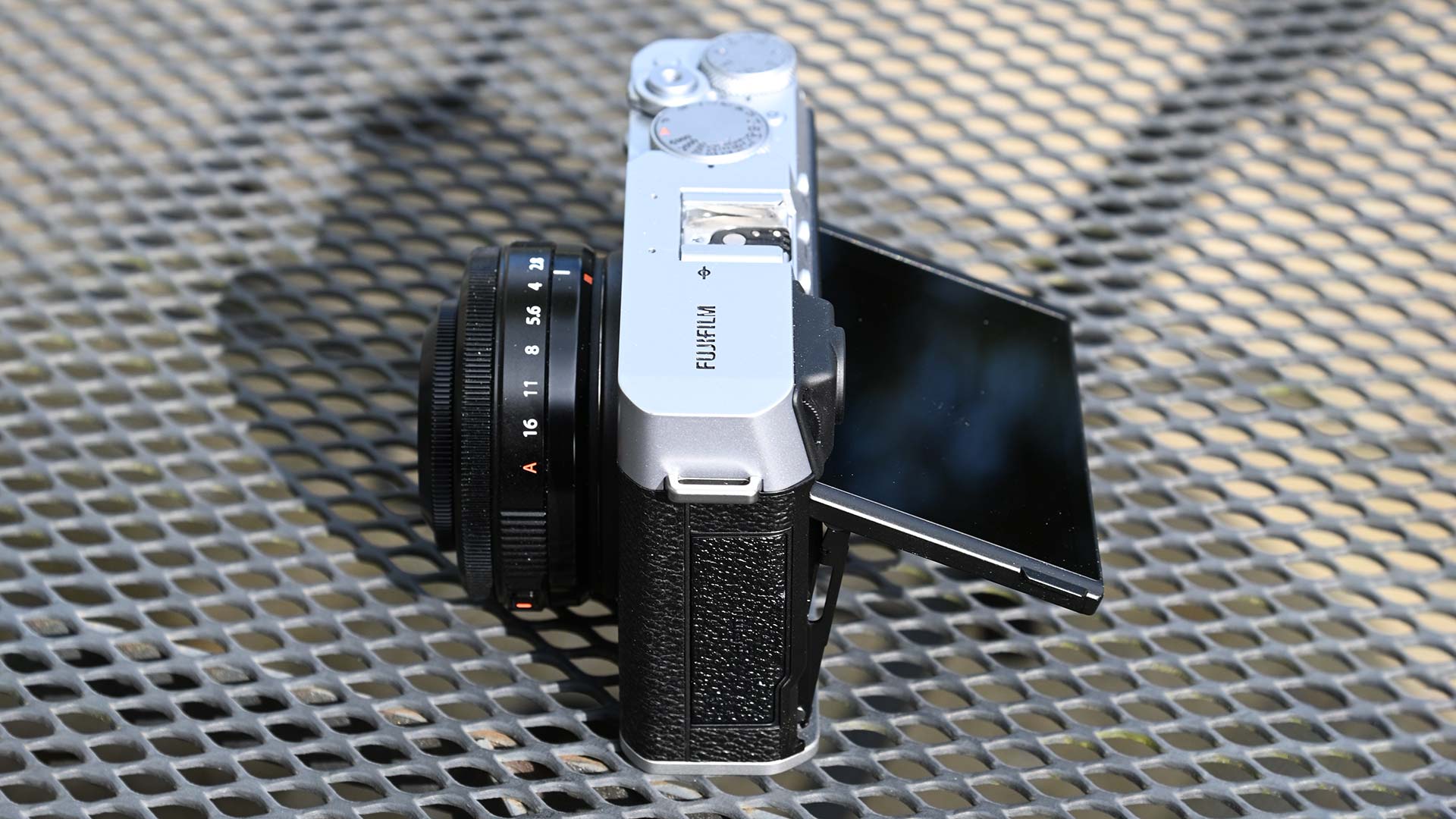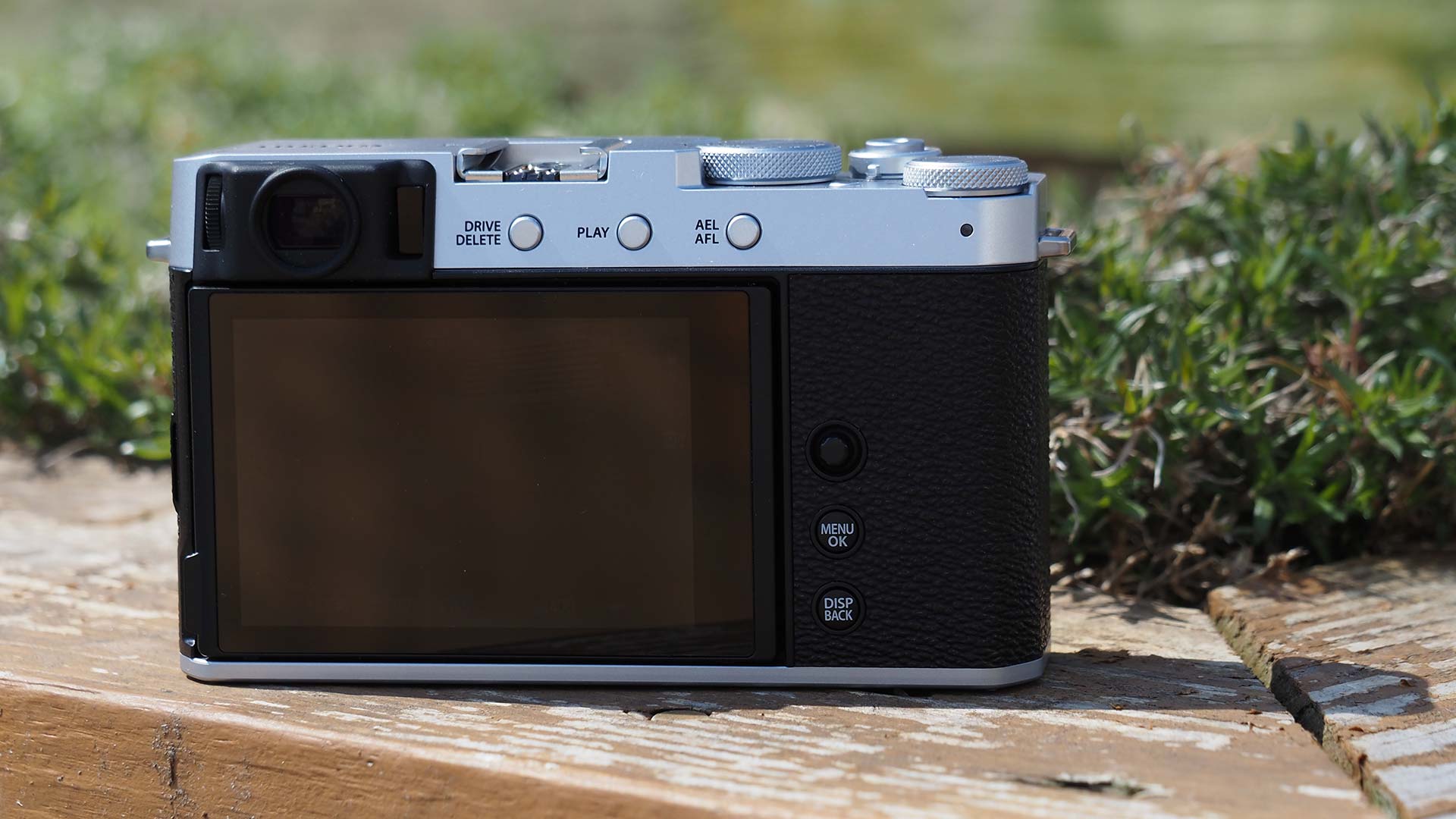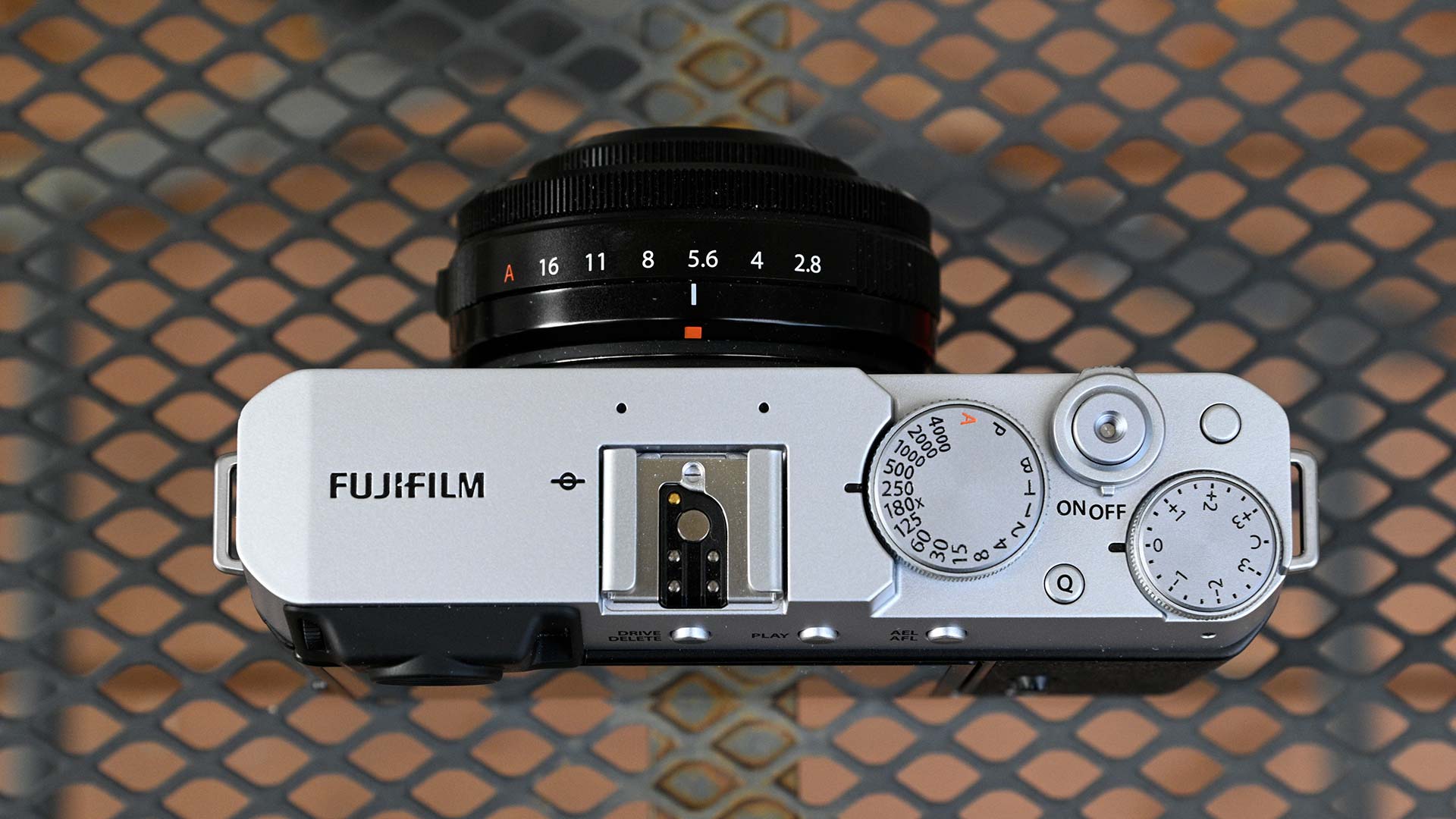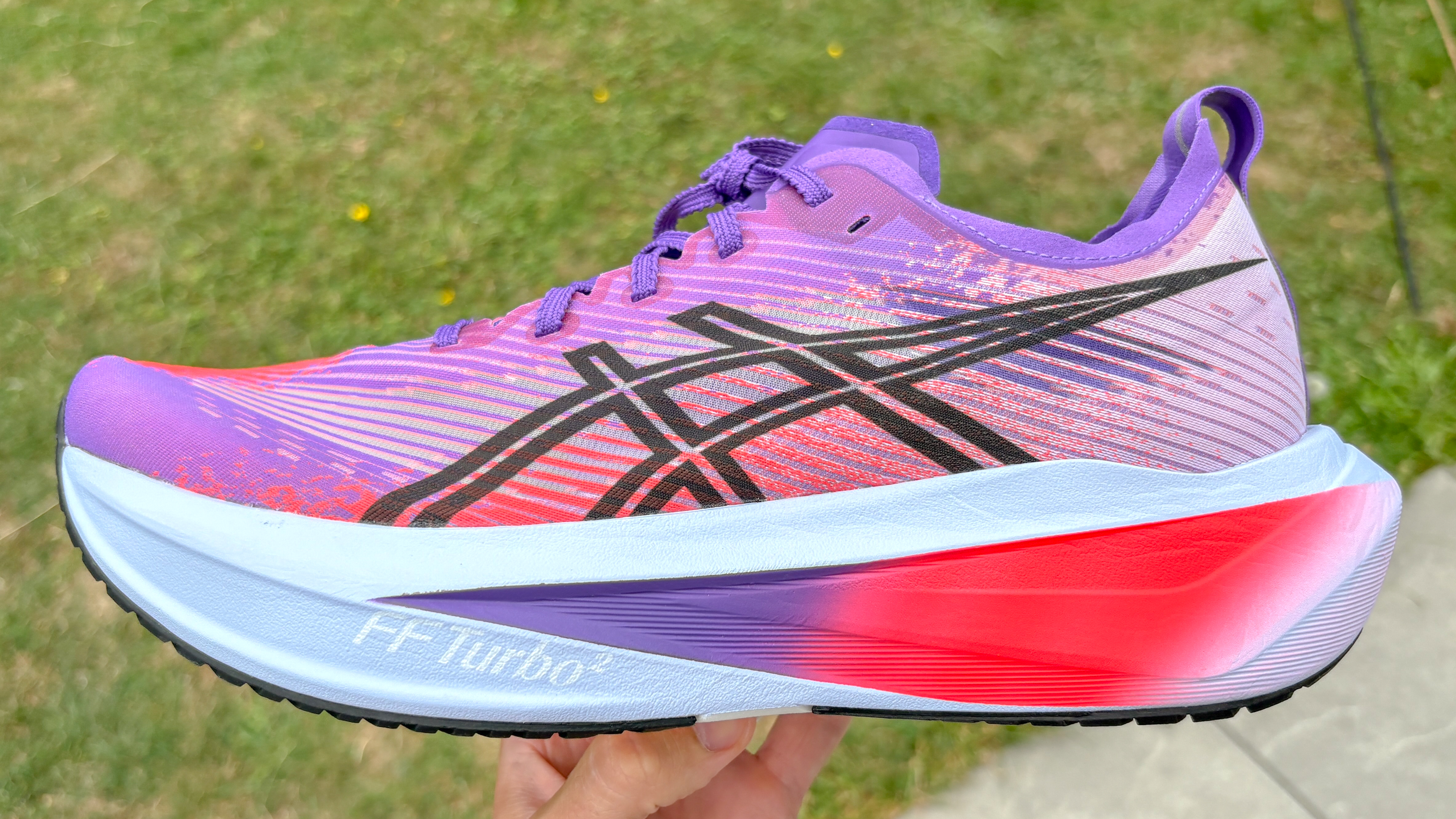Tom's Guide Verdict
The Fujifilm X-E4 packs a lot of features and excellent image quality into a highly portable body that’s perfect for street photographers, travelers and anyone who likes to carry a camera with them regularly.
Pros
- +
Excellent image quality
- +
Compact size
- +
USB charging
Cons
- -
No in-body image stabilization
- -
Minimal external controls
Why you can trust Tom's Guide
Image sensor: 26MP APS-C X-Trans CMOS
Storage media: SD/SDHC/SDXC UHS-1
Image stabilization: via OIS lenses
Display: 3.0-inch touch sensitive LCD
ISO: 160-12,800 (expandable to 80/51,200)
Max video resolution: DCI -E4K 4096 x 2160 @30/24 fps
Shooting speed: 8fps (20fps with electronic shutter; 30fps with 1.25x crop)
Wireless/Bluetooth: Yes
Ports: USB Type-C, HDMI micro connector (Type D), 3.5mm stereo mini adapter/connector (for mic and remote release)
Battery life: (approx.) 460 frames
Size (body): 4.77 x 2.87 x 1.28 inches
Weight: 12.84 ounces (with battery and SD card)
The Fujifilm X-E4 is the latest — and smallest — addition to Fuji’s popular X-series of mirrorless cameras. As an update to the Fujifilm X-E3, this model features a newer 26-megapixel sensor and processor, a flip-up LCD and a few design/control changes.
Its feature set will appeal most to experienced photographers and those who want to improve their picture-taking skills, because while you can set up the camera to be point-and-shoot simple, that’s not the X-E4’s strong suit. Rather, you’ll get the best experience by exploring its more advanced functionality.
This rangefinder-style camera will strike a cord with street photographers, but thanks to its compact size, the X-E4 is also great for travel and everyday photography. Fuji also offers a well-rounded line of X-mount lenses to choose from, including the new (and tiny) XF 27mm f/2.8 R WR — which is available in a bundle with the camera and which is the lens I used for testing.
- Best photo editing software
- Save your images in the cloud with the best photo storage and sharing sites
Read on for our full Fujifilm X-E4 review and find out what I liked and didn't like about it.
Fujifilm X-E4 review: Price and availability
The Fujifilm X-E4 in body-only guise retails for $849. Add the XF 27mm f/2.8 R WR lens for a bundled rate of $1,049. Both the camera and the lens are available now.
Fujifilm X-E4 review: Design

Weighing a mere 0.80 pounds and measuring 4.77 x 2.87 x 1.28 inches, the Fujifilm X-E4 is the smallest model in Fuji’s X-series line. Available in all black or black and silver, the X-E4’s minimalist design has a retro look and feel, reminiscent of 35mm film cameras. To achieve this streamlined body, the new model loses the modest grip and thumb indent of its X-E3 predecessor, resulting in a flat, boxy body.
Fuji offers an optional grip ($90) that attaches to the tripod socket and an accessory thumb rest ($70) that connects via the camera’s hotshoe, but I rarely found myself wishing that I had either accessory. The camera body is textured and I was generally able to maintain a solid handhold on the X-E4. However, photographers with larger hands may want to opt for both accessories. And, given the camera’s compact size and some tiny control buttons, they may want to try the X-E4 on for size before buying.
Get instant access to breaking news, the hottest reviews, great deals and helpful tips.

Adding to its rangefinder design aesthetic, the X-E4’s electronic viewfinder is positioned on the left upper corner of the camera. Left-eye dominant photographers may find the position a little uncomfortable with their nose pressed against the LCD, but the EVF is bright and clear regardless of your dominant eye.
The 3-inch touchscreen LCD provides 100% coverage and tilts up to 180-degrees for selfies and vlogging. There’s a small tab on the side of the monitor to lift it from its flat position; from there, it’s easy to adjust the screen for low-angle, overhead shooting and selfies/vlogging.
The touchscreen is responsive whether you’re tapping to select a focus point, swiping through images in playback mode or accessing one of several custom touch options. Although the Q (quick) menu settings are touch sensitive, you need to use the joystick or front command dial to navigate the standard menu.
There’s no built-in flash so you’ll need to purchase a standalone unit to fit the hotshoe if you need an extra kick of light. A single SD card slot shares the battery compartment on the bottom of the camera. Ports include USB Type-C and HDMI micro connector (Type D), plus the camera comes with a 3.5mm stereo mini adapter so you can connect a microphone or remote release.
Although the 27mm kit lens is weather resistant, the camera itself is not — so be careful in inclement weather or when working in harsh conditions.
Fujifilm X-E4 review: Controls
The Fujifilm X-E4’s control layout may be a little different to what you’re used to. All the functionality is there, but not necessarily where you expect it to be, especially since Fuji has further minimized the X-E4’s external controls compared to its X-E3 predecessor. For example, the new model loses the rear control dial, the view mode button and the focus mode dial on the front panel, among other changes.
Along the top panel you’ll find a large shutter speed/mode dial that now features a P (Program Auto Exposure) mode option. It’s here that you select the exposure mode and/or set the shutter speed. Unfortunately, the dial doesn’t turn 360-degrees and instead comes to a full stop at the B (Bulb) setting on one end and the P setting at the other end of the rotation, so you waste a little time changing settings.

Some X-series lenses, like the 27mm model we used for testing, feature an aperture ring, which is used to manual adjust f/stops. While I prefer this method, it may take a little time to get used to it. If the lens doesn’t have an aperture ring, you can set the command dial — which is in perfect position for your forefinger — to control aperture.
The on/off switch surrounds the small shutter button to the right of the shutter speed dial. A nice retro touch is the ability to use a manual cable release to trigger the shutter; although a remote option is also available, a manual cable release costs less and is simpler to set up.
A separate EV (exposure compensation) dial sits between the tiny Fn (Function) and Q (Quick Menu) buttons.
The back of the camera features a trio of small buttons to the right of the EVF. The Drive/Delete button provides a long list of options, including whether you want to shoot stills or movies, burst modes and bracketing settings to name a few. There are also playback and AEL/AFL buttons along the top back panel.
To the right of the LCD, you’ll find a joystick for setting focus points, a menu button and a display/back button.
Be sure to explore all the customization options such as populating the Q (Quick) menu with your most-frequently used settings. The X-E4 can also be customized so you can “flick” your finger up/down/right/left on the touchscreen to call up various functions such as histogram, electronic level and a host of other settings. (Tip: This option isn’t easy to find in the manual until you search on the word “flick.”) If you compose with the LCD versus the EVF, this little flick trick may be useful.
Fujifilm X-E4 review: Image quality
Given its similarities to its higher end sibling the Fujifilm X-T4, it’s no surprise that the X-E4 produces excellent image quality — both straight out of the camera (JPEGs) and in processed RAW files. With the option of using one of Fuji’s popular film simulations (the X-E4 has a whopping 18 choices), users can easily find a look that represents their aesthetic.
Provia is the default film simulation and is a great choice for most scenarios. In fact, most of my test shots were captured in Provia and resulted in accurate colors that were pleasing to the eye without being over (or under) saturated, as you can see in the photos below.



If you prefer a stronger intensity of color, try the Velvia film simulation.
For black and white, I prefer the Acros film simulation (versus Monochrome). Although both produce similar results, Acros seems to offer more contrast. Within the simulation, you can choose a subset filter for different effects (Green, Red, Yellow or Standard).
Test images were generally sharp and showed good detail. In this photo of lavender phlox, you can see tiny water droplets on some of the petals.
Overall, exposures were accurate and dynamic range was quite good as well. The trees and branches in this shot retained detail even while the white clouds against the bright blue sky were properly exposed.
The camera managed to maintain details at high ISOs, including this image shot at ISO 12800 (exposure was adjusted slightly in Adobe Camera Raw for better visibility).
For a different perspective, the camera’s Panorama feature is easy to use and does a good job capturing a broad vista.
Fujifilm X-E4 review: Video
As with its still image capabilities, the Fujifilm X-E4’s video is quite good, especially for a camera in this class. In addition to 4K/30p video, which can be recorded internally or to an external device via HDMI, this little camera also excels at full HD video — including 240p slow motion.
Colors are accurate and details are sharp. For a truly cinematic look, be sure to try the Eterna film simulation mode. I stuck with the standard Provia for video footage in my testing.
Unfortunately, without image stabilization and using a low-profile 27mm lens, it was difficult to keep the camera steady when shooting handheld. If I had a longer lens, I would have been able to cradle the lens in my hand for a little extra support, but the pancake-style 27mm lens provided very little surface to hold.
Unlike most cameras, there’s no red movie button. Instead, you have to press the Drive/Delete button, scroll down to choose Movie and then press the shutter button. It's not a deal breaker but it is something to be aware of, since it takes an extra few seconds to switch between stills and video.
The good news is that the camera is equipped with Zebra stripes, F-Log (8-bit), microphone jack and headphone jack. The latter requires the supplied adapter, though.
Fujifilm X-E4 review: Performance

For the most part, the Fuji X-E4 delivers responsive performance. You can quickly choose a focus point with the little joystick or by tapping on the LCD. Start up is quick and autofocus is (mostly) fast and accurate. Similarly, the camera easily hones in on faces and eyes.
Continuous shooting is speedy at up to 8 frames per second with the mechanical shutter. Switch to the electronic shutter for up to 20fps (30fps if you’re okay with a 1.25x crop). Unfortunately, autofocus tracking of fast moving action isn’t one of the X-E4’s strong suits, though, and it can’t keep up with the spritely continuous shooting speeds.
That said, the little X-E4’s AF is great for static subjects. Given its target markets — street photography and travel, for example — the camera’s AF is more than sufficient.
Battery life was better than expected for such a small camera: up to 460 still images or about 60 minutes for 4K video (75 minutes for full HD).
Fujifilm X-E4 review: Wi-Fi and Bluetooth
Fuji’s free Camera Remote app is available for iOS and Android mobile devices and works with Wi-Fi and Bluetooth. Set-up is relatively easy and the app generally works well.
Viewing and transferring images is quite simple, too. Keep in mind that the app resizes images to 3 megapixels; if you want to transfer full-resolution images, you can change the setting on the camera menu.
The app also provides an option to shoot remotely, which is great for times when you want to snap away from an unusual (and not easily accessible) angle. Remote shooting is also perfect for group shots — it’s a great alternative to a self-timer, since you can see the composition live.
Fujifilm X-E4 review: Verdict

The Fuji X-E4 is a highly capable companion for photographers who want a solid feature set and excellent image quality in a small body. Street photographers, travelers, everyday shooters and vloggers will appreciate the camera’s compact size and many attributes.
Given its minimalist design and unique shooting experience, some people may prefer a larger camera body with a more traditional design. The lack of in-body image stabilization may also be a deal breaker for those who tend to shoot at slow shutter speeds and who have a penchant for shooting video. If those attributes are important to you, consider the Fujifilm X-S10. At $999 (Amazon), it’s only about $150 more than the X-E4.
Other competitors include the Sony a6100 ($750), with its excellent autofocus. You may also want to check out the relatively petite Nikon Z50 ($855).
But the Fujifilm X-E4 offers a lot of excellence for the price and size. If Fuji’s X-series controls are new to you, that’s not a good reason to shy away from this camera — in fact, you may actually enjoy its unique shooting experience.
Next: The Fujifilm X-E4 wasn't the camera I wanted — but I am so glad I bought it.
- More: These are the best cameras right now
Theano Nikitas is a freelance journalist and photographer. She's been writing about photography for more than 20 years, contributing countless reviews of cameras, lenses, accessories and software packages to Tom's Guide. Her work has also appeared in dozens of other magazines and websites, including CNET, DPreview, PopPhoto, Professional Photographer and Shutterbug.







